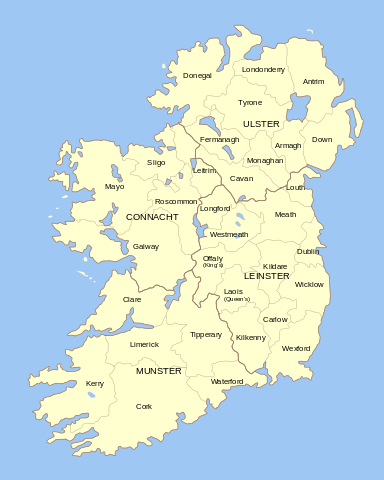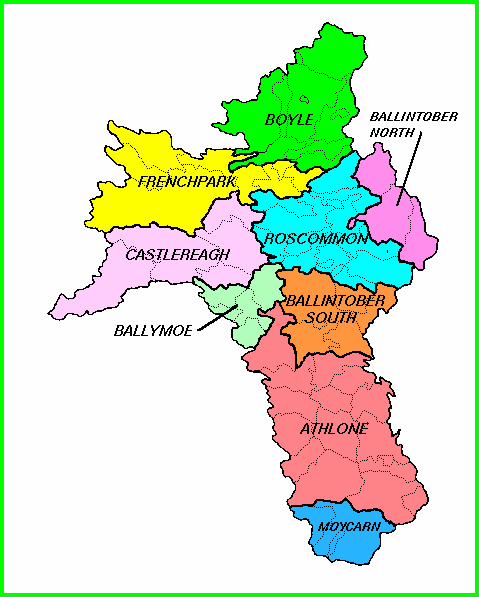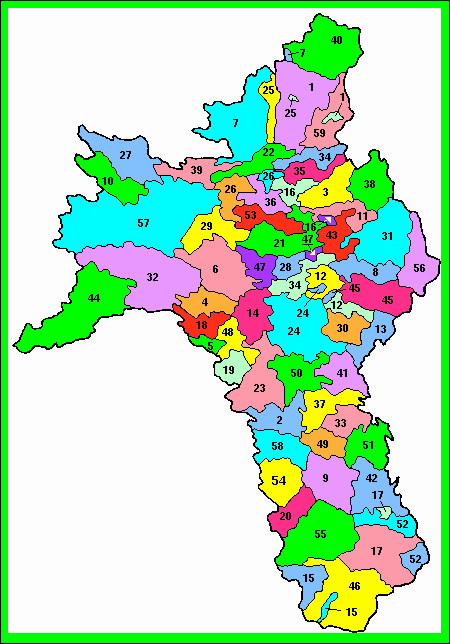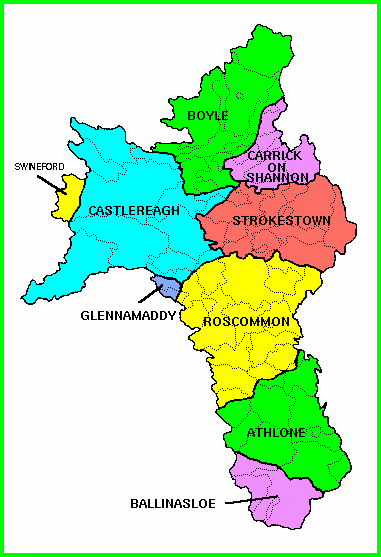Irish Jurisdictions - Irish Places
Understanding jurisdictions is key to successful research.
To know where to look for records, you first need to understand where the records were created and where they are kept.
Provinces:
There are four provinces based upon area of ancient kingdoms: Ulster, Leinster, Connaught. and Munster. Today the Munster Counties of Down, Armagh, Fermanagh, Tyrone, Londonderry and Antrim constitute Northern Ireland.
Counties:
There are 32 counties in all. Twenty six are in the Republic of Ireland and six in Northern Ireland. The names have changed with time. Remember there was only one country on the island of Ireland prior to 1922. What was County Queens is now County Leix (or somtimes Laois) and what was County Kings is now County Offaly.

Baronies:
These divisions were based on clan territories. At times they were the administrative districts for tax collection, land records and 19th Century censuses. They are little used in the 20th Century. Here are the Baronies of County Roscommon.

Civil Parishes:
The counties are divided into parishes. There are 2,500 in all of Ireland. Some cross County boundaries and some of their boundaries have changed with time. Here is an example showing County Roscommon divide up into its Civil Parishes.

Church of Ireland Parishes:
Most of these have the same name and boundaries as the civil parishes.
Roman Catholic Parishes:
Often the names and boundaries of these do not coincide with those of the Civil Parishes. These can cross County boundaries. Here are the Roman Catholic Parishes of County Roscommon by way of example.

Dioceses:
These have no relationship to County boundaries. They are different for the Roman Catholic Church and the Church of Ireland. The number of these have varied over the years.
Townlands:
These are the most ancient divisions. They are the smallest surveyed unit. There are 60,462 of these ranging from one acre to over 7,000 acres. Most are around a couple of hundred acres. A Townland is not a town. A townland may contain a town, or a town may contain several Townlands or parts of Townlands.
Poor Law Unions (PLU):
These divisions were set up in 1838. There were 130 at first with 160 created by 1850. They are centered in larger market towns. Each had a workhouse in the center town. These were catchment areas for taxes to support the poor. Some cross County boundaries. Here are the Poor Law Unions of County Roscommon.

PLUs and Civil Registration:
-
From 1843 to 1843 PLUs called Registrar's Districts.
-
From 1863 on PLUs called Superintendent Registrar's District (SRD).
-
From 1851 on each PLU divided into five Dispensary Districts.
-
From 1863 on Dispensary Districts equaled Registrar's Districts.
-
From 1898 on PLU became the basic administrative district rather than the Civil Parish and Barony used previously.
Finding places and jurisdictions in print and online:
General Alphabetical Index to the Townlands and Towns, Parishes and Baronies of Ireland. Based on the Census of Ireland for the Year 1851. 1861 Reprint, Baltimore: Genealogical Publishing Co., 1984.
Handran, George B. Townlands in poor law unions: a reprint of poor law union pamphlets of the General Registrar's Office. Salem, Mass., U.S.A.: Higginson Book Co., 1997.
Mitchell, Brian. A Guide to Irish Parish Registers. Baltimore: Genealogical Publishing Co., Inc., 1988.
Mitchell, Brian. A New Genealogical Atlas of Ireland, 2nd edition. Baltimore: Genealogical Publishing Co., Inc., 2002.
Online
IreAtlas: let's your look up a place name and thereby find the names of the related districts, eg. look up a Civil Parish and find the Townlands with it, thier sizes in acres and the related County, Barony, Civil Parish and PLU.
Irish Place Names and the Immigrant, article by Radford and Betit is excellent on how to find an immigrant's place of origin and how to understand Irish jurisdictions.
Irish Placenames at John Grenham's website is one of the best places to see Civil Parish, Roman Catholic Parish, and Poor Law Union maps for each county and lists of Townlands with in Civil Parishes. This sitt also has links to Griffith's survey listings for the Townlands, 1901 and 1911 census listings and resources relating to the Civil Parish.
Placenames Database of Ireland, Logainm, is excellent for showing alternative spellings that may have been used over the years for any given place.
General Alphabetical Index to the Townalnds and Towns, Parishes and Baronies of Ireand, is the definitive work on this topic. This can be searched in several different ways at Townland Index and Database - 1851.
For better understanding of the origin and meaning of Irish place names this Wikipedia article is helpful.
